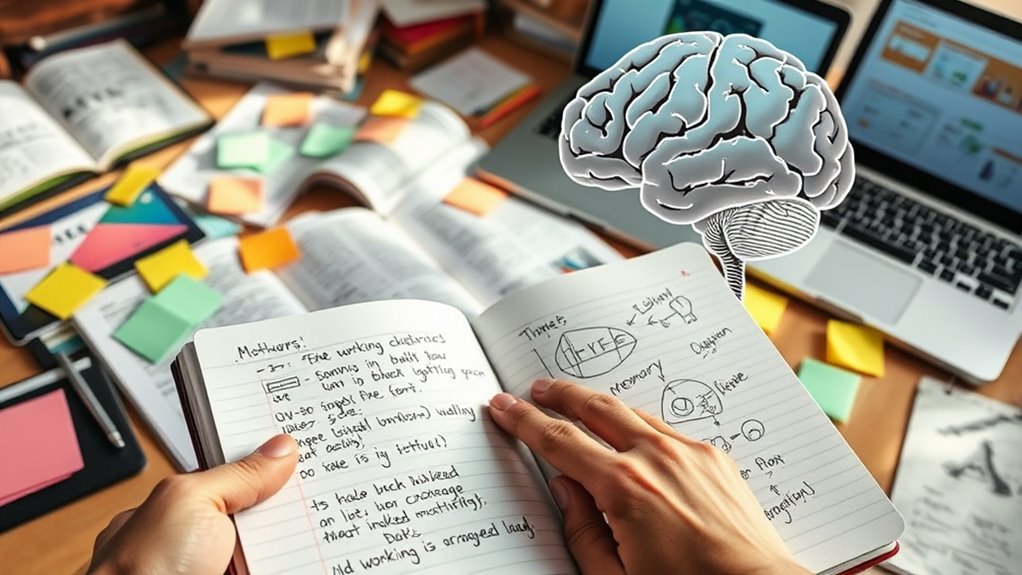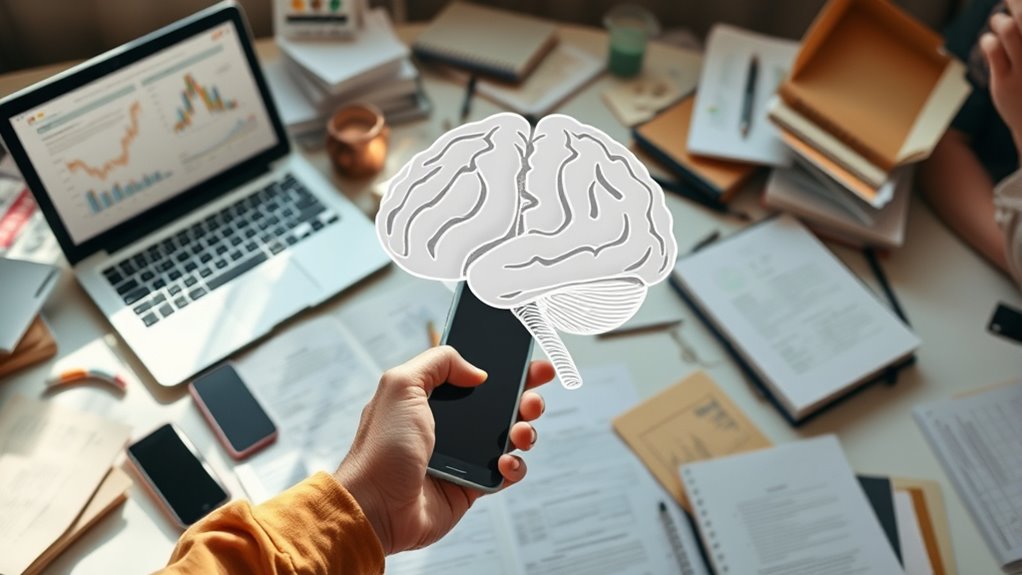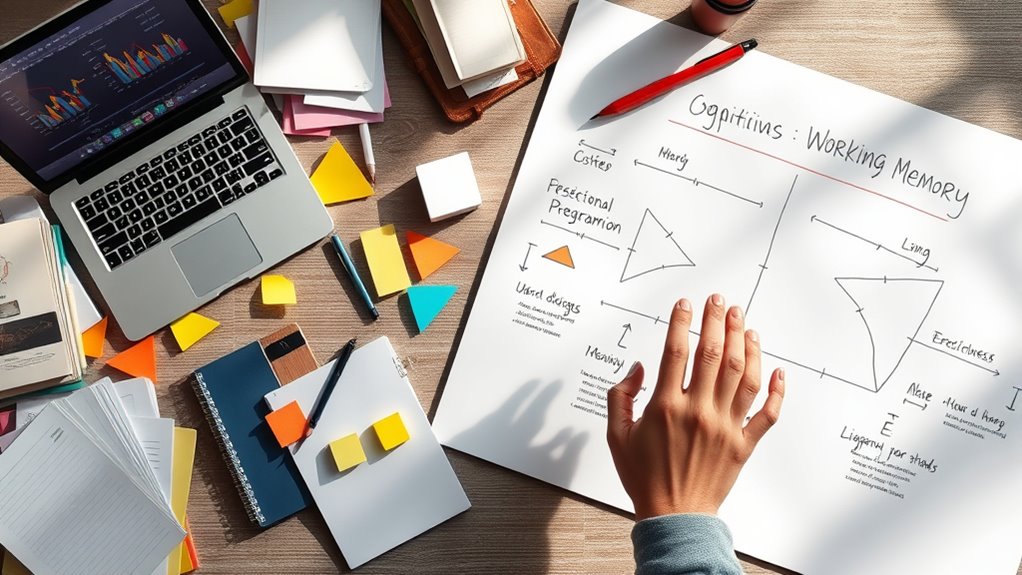Cognitive load refers to the mental effort required to learn or solve problems, divided into intrinsic (task complexity) and extraneous (how information is presented) types. Working memory is your brain’s temporary storage, holding about 4 to 7 items at once for processing. While cognitive load influences how hard your working memory is working, managing both effectively helps improve learning. To understand how these concepts interplay, keep exploring—they reveal how your mind maximizes efficiency.
Key Takeaways
- Cognitive load refers to the mental effort required for learning or problem-solving, while working memory is the brain’s temporary storage system.
- Cognitive load is a property of tasks or instructional design; working memory is a cognitive system with limited capacity.
- Managing cognitive load aims to optimize learning by preventing overload; working memory capacity constrains how much information can be processed at once.
- High cognitive load can overload working memory, impairing retention and comprehension.
- Strategies like chunking and organization help manage cognitive load and support working memory efficiency.
Defining Cognitive Load and Its Types

Cognitive load refers to the mental effort required to process information during learning or problem-solving. It has different types, mainly intrinsic and extraneous load. Intrinsic load depends on the complexity of the material and your prior knowledge; tougher concepts require more mental effort. Extraneous load, on the other hand, comes from how information is presented. Poorly organized or confusing instructions increase this load unnecessarily, making learning harder. Your goal is to manage these loads effectively to optimize learning. Simplifying complex topics can reduce intrinsic load, while clear, focused presentations decrease extraneous load. Recognizing these types helps you identify ways to enhance understanding and avoid overwhelming your working memory during the learning process. Additionally, understanding the importance of environmental considerations can support sustainable and effective learning environments.
Understanding Working Memory and Its Capacity

Understanding how your working memory functions is key to managing cognitive load effectively. Your working memory relies on neural mechanisms that temporarily hold and process information essential for tasks like reasoning and learning. Typically, your memory capacity is limited, allowing you to handle about 4 to 7 items at once. To optimize this, consider these points:
- Neural mechanisms involve specific brain regions, like the prefrontal cortex
- Memory capacity varies between individuals and contexts
- Working memory acts as a mental workspace for active processing
- Overloading it impairs your ability to retain and manipulate information
- The efficiency of working memory depends on its capacity and the complexity of the task at hand
Recognizing these limits helps you tailor your approach, reducing unnecessary mental strain and improving overall cognitive performance.
The Relationship Between Cognitive Load and Working Memory

Since your working memory has limited capacity, managing cognitive load becomes essential to prevent overload. Cognitive load directly affects how much mental effort you need for information processing. When cognitive load is high, your working memory struggles to handle additional tasks, leading to decreased efficiency. Conversely, when cognitive load is low, your working memory can focus on relevant information without strain. This relationship highlights that cognitive load acts as a gatekeeper, influencing how effectively your working memory functions during learning or problem-solving. If the load exceeds your working memory’s capacity, mental effort increases dramatically, making it harder to process and retain information. Recognizing the effects of eye patches on mental clarity and refreshment can also inform how you manage visual fatigue and cognitive demands. Understanding this connection helps you optimize tasks to match your working memory’s limits, ensuring smoother information processing.
How Each Concept Impacts Learning and Problem Solving

When cognitive load is managed effectively, your ability to learn and solve problems improves markedly. High intrinsic load, which stems from task complexity, can challenge your working memory, making learning harder. Conversely, extraneous load, caused by unnecessary or poorly designed information, diverts mental resources away from essential learning. By reducing extraneous load, you free up capacity for processing core concepts. This balance allows you to:
- Focus on relevant information without distraction
- Better understand complex ideas
- Retain information longer
- Solve problems more efficiently
Managing intrinsic load through appropriate task complexity and minimizing extraneous load helps optimize your cognitive resources. Additionally, understanding the factors influencing cognitive load can guide you in designing more effective learning experiences. Ultimately, this enhances your learning experience and sharpens your problem-solving skills.
Strategies for Managing Cognitive Load and Optimizing Working Memory

To effectively manage cognitive load and optimize your working memory, you should adopt targeted strategies that streamline information processing. One effective method is using chunking techniques, which break down complex data into manageable units, making it easier to remember and understand. Additionally, practicing attentional control helps you focus on relevant information while filtering out distractions, reducing unnecessary cognitive load. Organize information visually or hierarchically to facilitate quick access and comprehension. Prioritize tasks to avoid overload and give your working memory space to essential details. Regularly reviewing and rehearsing information also strengthens memory retention. According to the best vacuum expert, selecting the right tools for cleaning, such as vacuums with advanced filtration systems, can significantly reduce indoor allergens and improve air quality. By combining chunking techniques with attentional control, you can enhance your ability to process information efficiently and improve overall cognitive performance.
Frequently Asked Questions
How Do Cognitive Load and Working Memory Interact in Real-World Scenarios?
In real-world scenarios, you often face attention overload, which increases mental effort and strains your working memory. When your cognitive load is high, your working memory struggles to process and manage information effectively. This interaction can slow your decision-making and reduce learning. To stay efficient, you need to minimize unnecessary mental effort, avoid overload, and give your working memory the capacity it needs to function *preferably*.
Can Cognitive Load Affect Long-Term Memory Formation?
Imagine trying to build a sturdy bridge while juggling too many heavy stones. When cognitive load is high, it overwhelms your working memory, making it harder for your brain to focus on memory consolidation. This can impair long-term retention, as your brain struggles to transfer new information into durable storage. So, excessive cognitive load hampers your ability to form strong, lasting memories, affecting long-term memory formation.
Are There Individual Differences in Working Memory Capacity?
You might wonder if there are individual differences in working memory capacity. The answer is yes; people vary widely in how much information they can hold and process at once. These capacity differences, or capacity variability, influence how well you can learn and perform tasks. Factors like age, training, and cognitive strategies contribute to these differences, meaning your working memory isn’t fixed but adaptable based on your experiences and needs.
How Does Multitasking Influence Cognitive Load and Working Memory?
When you multitask, you increase your cognitive load, making attention management harder. Task switching forces your working memory to constantly update, which can cause errors and reduce efficiency. As you juggle multiple activities, your brain struggles to focus on each task, leading to mental fatigue. To improve performance, limit task switching and prioritize tasks, allowing your working memory to function effectively without becoming overwhelmed.
What Are the Latest Research Findings on Optimizing Both Concepts?
You want to optimize cognitive load and working memory, so recent research suggests reducing extraneous load by simplifying information and instructions. Focus on managing intrinsic load based on task complexity, breaking tasks into manageable steps. Using visual aids and chunking information helps. Additionally, designing learning environments that minimize distractions and optimize information flow enhances your working memory capacity, making learning more efficient and less overwhelming.
Conclusion
By understanding how cognitive load and working memory intertwine, you realize they’re more than just concepts—they’re the silent forces shaping your learning and problem-solving. When you manage your cognitive load wisely, you often find your working memory unexpectedly expands, revealing new insights. It’s a subtle coincidence: reducing mental clutter quietly liberates your mind’s potential, guiding you effortlessly through challenges and turning complexity into clarity. Embrace this balance, and growth becomes an inevitable part of your journey.









